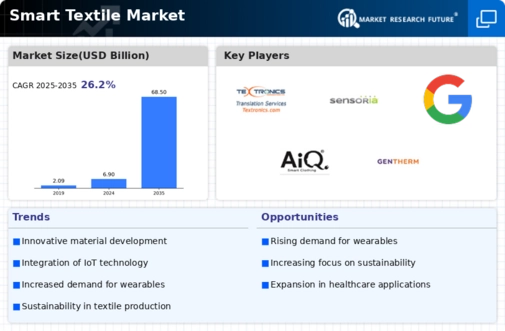Top Industry Leaders in the Smart Textile Market
 Beyond the surface of fashionable threads lies a revolution – the Smart Textile market. These intelligent fabrics, infused with sensors, electronics, and even light-emitting capabilities, are no longer confined to science fiction. From self-heating jackets to health-monitoring sportswear, they are weaving their way into diverse applications, blurring the lines between fashion and technology. But beneath the seemingly seamless weave lies a competitive jungle where established players and innovative startups grapple for market share amidst evolving trends, technological advancements, and regulatory constraints. Let's explore the strategies, factors, and recent developments shaping this fascinating frontier.
Beyond the surface of fashionable threads lies a revolution – the Smart Textile market. These intelligent fabrics, infused with sensors, electronics, and even light-emitting capabilities, are no longer confined to science fiction. From self-heating jackets to health-monitoring sportswear, they are weaving their way into diverse applications, blurring the lines between fashion and technology. But beneath the seemingly seamless weave lies a competitive jungle where established players and innovative startups grapple for market share amidst evolving trends, technological advancements, and regulatory constraints. Let's explore the strategies, factors, and recent developments shaping this fascinating frontier.
Strategies Stitching Together Market Share:
-
Product Diversification: Leading players like Schoeller Textil, Patagonia, and Levi Strauss & Co. are constantly expanding their offerings, creating specialized smart textiles for specific applications. Think medical textiles infused with biocompatible sensors for health monitoring, sports apparel with integrated temperature controls, and smart fabrics for wearable electronics. -
Collaboration and Partnerships: Combining textile expertise with technological know-how is crucial. Companies like Teijin Limited and Microsoft are collaborating to develop smart threads embedded with microprocessors, while Intel partners with Levi's to integrate smart tags for contactless payments. -
Sustainability Focus: Environmental consciousness is influencing the market. Players are adopting eco-friendly manufacturing processes, using recycled materials, and developing biodegradable smart textiles to minimize environmental impact and cater to sustainability-driven customers. -
Geographical Expansion: Emerging economies in Asia and Africa present immense growth potential, driven by rising disposable incomes and increasing demand for advanced apparel. Companies like Xiaomi and Mahindra & Mahindra are establishing production facilities and forging partnerships in these regions to capitalize on this trend.
Factors Influencing Market Growth:
-
End-User Industries: Sportswear and healthcare remain the primary drivers, consuming over 50% of global smart textile production. Growing fitness trends and rising healthcare awareness contribute to this demand. -
Technological Advancements: Research and development efforts are leading to novel materials, improved sensor integration techniques, and the development of flexible electronics tailored for textile applications. Early adopters and innovators stand to benefit significantly from these advancements. -
Regulation and Safety: Stringent regulations on wearable electronics, material safety, and data privacy, like GDPR in Europe and HIPAA in the US, drive the development of safe and compliant smart textiles. Companies complying with these standards gain a competitive edge. -
Consumer Preferences: Growing demand for personalized experiences and enhanced functionality fuels the adoption of smart textiles offering health monitoring, environmental adaptation, and interactive features. Think intelligent jackets automatically adjusting to weather conditions or clothing embedded with personalized health trackers.
Key Companies in the Smart Textile market include
- Interactive Wear AG (Germany)
- Google Inc. (U.S.)
- AiQ Smart Clothing (Taiwan)
- GENTHERM (U.S.)
- Clothing+ (Finland)
- Textronics Inc. (U.S.)
- Outlast Technologies LLC (U.S.)
- Sensoria Inc. (U.S.)
- Thermosoft International Corporation (U.S.)
- Ohmatex ApS (Denmark).
Recent Developments
July 2021, DuPont bought Laird Performance Materials. Laird Performance Materials is a well-known firm that provides heat management solutions as well as high-performance electromagnetic shielding.
February 2021, DuPont purchased Tex Tech's Core Matrix Technology. The acquisition will add to the company's already extensive offering of life protection solutions. This will enable lightweight ballistic and most flexible solutions to meet new National Institute of Justice (NIJ) durability standards.










